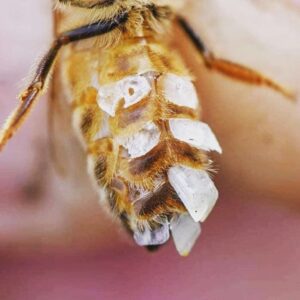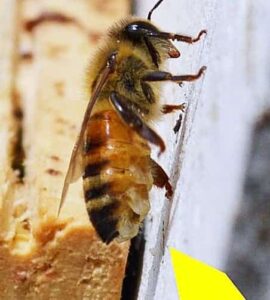


Young worker bees are charged with the task of making beeswax for the colony. Soon after a new worker bee emerges as an adult, it begins producing wax. Honey bee workers have four pairs of special wax-secreting glands on the undersides of their abdomens. From these glands, they secrete liquified wax, which hardens into thin scales when exposed to the air. As the worker bee ages, these glands atrophy and the task of making wax is left to younger bees.
During its peak wax production phase, a healthy worker bee can produce about eight scales of wax in a 12 hour period. The bee colony requires about 1,000 wax scales to make a single gram of beeswax for their comb. The geometry of the honeycomb allows the bee colony to maximize their storage space while minimizing the quantity of wax needed to build the structure.

After the soft wax hardens, the worker bee uses stiff hairs on her hind legs to scrape the wax from her abdomen. She passes the wax forward to her middle legs, and then to her mandibles. The bee chews the wax until it is pliable, and carefully shapes it into the hexagonal cells that make up the colony’s honeycomb. Worker bees use their mouths to measure the thickness of the honeycomb as they build it, so they know whether more or less wax is needed.
“Pharmaceutical” use of beeswax dates back to ancient Egypt: as reported by the Ebers Papyrus (1550 B.C.), beeswax was the main ingredient in many recipes for the preparation of ointments and creams used to help pull plugs, to treat burns and wounds and to soothe joint pain.
The “father of medicine”, Hippocrates, recommended the use of beeswax in case of purulent tonsillitis. In ancient Rome, many doctors of the time used to apply a cream known as “cold cream”, which contained olive oil, beeswax and rose water for the treatment of burns, wounds, cuts, bruises and fractures.
Beeswax was one of the components of the first cosmetic cream, which was created by Galen, the great Greek physician, in 150 B.C., composed of beeswax and olive oil, with emulsion of water (or rose water). Beeswax plays an important role also in Ayurvedic medicine, the ancient and traditional Indian medicine, with the name of Madhuchishtha. In Western countries, the search for natural products to be used together with drugs or, even, to replace them has lead to a “rediscovery” of Ayurvedic medicine.
The Madhuchishtha (beeswax) is used for the care of wounds from abrasion or even from burns with topical application; it has been shown to be particularly effective in the treatment of heel cracking. Some reports highlight the use of Madhuchishtha in combination with other natural products or mixtures, like Madhu (Honey) or Guda (Jaggery) or Taila (Oil) Today beeswax is widely studied and used for human medicine.
Using beeswax on leather can be an excellent way to condition and protect your leather goods. Beeswax helps moisturize the leather, prevent it from drying out, and create a protective barrier against moisture and stains.
Leather, with its natural allure and timeless appeal, has adorned human lives for centuries. Whether it’s a cherished leather jacket, a beloved pair of boots, or a vintage leather sofa, these pieces often become an integral part of our lives.
However, to maintain their beauty and extend their lifespan, leather goods require proper care and nourishment.
We recommend to use beeswax leather balm, a natural and time-tested solution that not only protects but also enhances the longevity of your favorite leather ware. What are the benefits of beeswax leather balm.
The primary role of beeswax leather balm is to provide deep conditioning to your leather items.
Leather, being a natural material, can dry out over time, leading to cracks and a loss of suppleness. Beeswax, combined with other natural oils, penetrates deep into the leather’s fibers, restoring moisture and ensuring your leather remains soft and flexible.
Leather is often exposed to various environmental elements, including moisture, UV rays, and pollutants. Beeswax, known for its water-repellent properties, creates a protective barrier on the leather’s surface. This barrier not only guards against rain and spills but also shields leather from harmful UV rays, preventing fading and discoloration. Furthermore, the protective layer makes leather more resistant to dust and dirt, keeping it cleaner for longer.
The application of beeswax leather balm leaves your leather items with a rich, healthy shine. This natural glow not only enhances their apparel but also serves a practical purpose. The balm helps disguise minor scratches and scuffs, keeping your leather looking newer for longer.
It’s like giving your leather goods a second lease on life.
Many commercial leather care products contain chemicals that can be harmful to both the leather and the environment. Beeswax leather balm, on the other hand, is made from natural ingredients, making it eco-friendly and safe to use. You can protect your leather without compromising on sustainability.
Beeswax leather balm isn’t limited to specific leather goods; it’s versatile enough to be used on a wide range of items. From leather jackets and handbags to boots, wallets, car interiors, and even furniture, this balm caters to all your leather care needs. Its versatility ensures that your entire collection benefits from its protective embrace.
Applying beeswax leather balm is a simple and enjoyable process. It doesn’t require professional expertise, and you can do it at your convenience. A thin, even layer of balm can be applied with a soft cloth or sponge and then buffed to perfection, revealing the leather’s natural sheen.
While beeswax is an effective leather conditioner, it’s important to note that it may darken the leather slightly, especially if applied to light-colored leather. Therefore, it’s advisable to test a small, inconspicuous area before applying it to the entire item, especially if you’re concerned about potential changes in color or finish. Additionally, for specialized leather care, such as exotic leather or heavily distressed leather, it may be best to consult with a professional or refer to the manufacturer’s recommendations.
Based in Northern NSW, Black Dog Honey is a supplier of local, Australian owned and operated raw honey products. Offering a range of products, Black Dog Honey now ships Australia-wide.
"*" indicates required fields